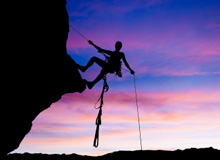Jeffrey S. Ashby is a former NASA space shuttle commander, the typical hero-type astronaut — ex-Top Gun former Navy pilot, combat missions in the Middle East, three Space Shuttle missions. John Kanengieter is cut from that same cloth, but more earth-bound. He is director of leadership at the National Outdoor Leadership School — climbing mountains, leading expeditions, following the adventure path. Stephen Girsky is vice chairman of GM with overall responsibility for corporate strategy, business alliances, new business development and other areas, and also holds the title of chairman of the Adam Opel AG Supervisory Board.
All three spoke at the recent 16th Annual Wharton Leadership Conference — sponsored by Wharton’s Center for Leadership and Change Management and Center for Human Resources — whose theme was “Leading in a World of Conflict.”
In an interview that same day, Girsky spoke with Wharton management professor John Paul MacDuffie about GM’s renewed emphasis on the customer even as it faces such challenges as industry-wide overcapacity, strong competition from rivals both in the U.S. and Europe, and slower-than-expected sales of the Chevy Volt. Click here for that interview in both print and audio format.
Meanwhile, Ashby and Kanengieter offered leadership lessons that they noted apply not only to their outsized adventure worlds, but also to the boardroom and conference tables of the more conventional business community. Essentially, Ashby and Kanengieter said, it comes down to preparation, a single-minded focus on the goal and a team of what they called “active followers.”
Each of the men made their points by talking about key moments in their respective careers. In Ashby’s case, it was commanding an International Space Station docking-and-repair mission — number 112, on the Atlantis in October 2002. For Kanengieter, it was his part in an Indian/American attempt to scale Panwali Dwar — at 21,000-plus feet, one of the tallest and most difficult mountains to climb in the Indian portion of the Himalayas.
Cold Mountain
Ashby began his saga by noting that NASA puts together its most important crews — those who take on Space Shuttle missions — in a way that would seem unconventional in a normal corporate setting. Approximately nine months before Mission 112 was to take off, Ashby received an 11 p.m. call from NASA headquarters congratulating him on being named Mission commander. But headquarters also told him that it had already picked his crew — i.e., he would have no say in who would be on that crew, and yet he would be expected to make sure everyone worked well together and completed the mission successfully.
In the early days of NASA space missions, Ashby said, the Mercury, Gemini and Apollo astronauts were assumed to be leaders. “They were all military pilots, and all had military leadership training.” By the 1990s, the commanders were still military, but “it was a different kind of setting with the International Space Station.” Now, instead of all military people, there were scientists and other mission specialists who were important — and not necessarily motivated by military-type leadership. There needed to be a different way to mold the six or seven crew members — each one of them responsible for delicate and complex tasks — into a cohesive unit.
That is where Ashby said his path crossed with Kanengieter and the National Outdoor Leadership School. He decided to take his diverse crew — one woman, a Russian who spoke no English, his pilot and a medical doctor among them — to the Canyonlands of Utah for an 11-day wilderness trek, the same length as their future Space Shuttle mission.
Ashby intended to make it as arduous and challenging as possible. He knew that seven days together on a mission was just about the limit before breakdowns — arguments, resentments and the like — would occur. In addition, he took the crew to Utah’s mountains in November, just as it was getting cold and damp. Each day, he changed leaders — the mission was to traverse a set of canyons and mountains across the National Park — so everyone would get a chance to be at the head and also in the “active following” positions.
At one point, near a passage filled with cascading water, the group was strung out so that those in front could not see or hear those in back. One of those in the back suggested returning the way they had come and circling around — taking the longer, but safer, route. He was eventually overruled, and the group decided to slog through the rushing water to the more direct route.
What was key for Ashby, though, was that the overruled crew member — instead of sulking or arguing — volunteered to be the person who would lift and guide everyone through the most dangerous part of the rock wall where the water was rushing down. “He disagreed, and yet he gave his full commitment,” noted Ashby. “I knew then that we would be a team and we would make it. Even [though there was] disagreement, it set the tone for the trip — and later the mission. The behavior was [defined by a sense of] respect and cooperation.”
According to Ashby, these qualities were especially important once the mission began. The most crucial part would be docking with the repair materials for the International Space Station. It is a two-day trek from take-off to docking — an almost incomprehensible piece of precision, hooking together 240 miles up at 18,000 miles per hour.
Everything was fine until about three miles away and three minutes out when it suddenly became apparent from computer readouts that a calculation was wrong. “You only get one shot at docking, because that is all the fuel you have in the thrusters,” said Ashby. It was not that they faced a death-defying situation, he added. Nevertheless, aborting a billion-dollar mission because of a miscalculation was not what leadership was about. For several minutes, Ashby went back and forth with his crew, trying to figure out what was wrong with the readout, the computers, the mission itself. Finally, the word came from Houston, with about a minute to go: “Do what you think is right.”
“What do you want from a leader then?” Ashby asked. Everything comes “down to a moment.” Right about then, he added, everything they had worked for — from that trek in the Canyonlands to the trust they had given each other — came to the fore. One crew member flashed through the readouts; another put his use of radar to the test, and all stated that they had confidence in Ashby’s decision-making. In the end, rather than depend on mere computers, Ashby led the pilot manually, to the point of looking out the window like a parent instructing his teenager to drive. The mission was saved.
Trapped by Avalanches
Kanengieter’s mountain climb was not a billion-dollar effort, but it would be high up on the mountaineering scale since only one team had ever scaled Panwali Dwar before. It had taken a month to establish three base camps at various altitudes. The team finally made it to the third camp at 18,000 feet.
Then a series of snowstorms, creating several avalanches, trapped the team for several days. There was only so much time they could spend in the rare air and freezing cold of 18,000 feet. But on the last possible day, a clearing came, and Kanengieter and the team leader set out to rappel the last leg of the journey.
Minutes after they were lined up by rope, about 150 feet up-and-down from one another, they heard a cracking sound. The snow that had come down from the avalanches was fissuring, caused by an air pocket below. About 15 feet ahead of the leader, the ice was starting to fracture. “My life was hanging by a thread, but which way should we go — up or down?” said Kanengieter. In this case, each of the people had significant knowledge about mountain climbing, but the point was to make a decision. The leader wanted to go on, but Kanengieter — intuiting that the fracture would, at best, thwart the route to the top and, at worst, cause an avalanche that would kill the men — overruled him.
“I was a follower there — an active follower — and my job was to figure out how to help support the leader to make a critical decision,” said Kanengieter, who noted that he could see better from below the real danger they were in. “Our leadership model leverages the strength of active followers, which is highly effective during uncertainty and times of conflicting options.” Though the mission had to be aborted and the goal was never reached, the leader and the rest of the team members respected Kanengieter’s knowledge and former leadership skills.
As Ashby and Kanengieter noted, leadership is not one-dimensional and autocratic. Yes, the leader has to make the final decision, but not without real input, which cannot be given by team members unless they are empowered all along the way by the leader. It is this concept of the active follower that Ashby and Kanengieter claim is essential. They gain it by trust, a focus on the goal and proper communication, not just at the crisis moment, but from the first day of the team’s selection. Even if the goal, as in the mountain climb, has to be abandoned, the entire group buys in.
“It works in mountaineering, in space and in the business world,” said Ashby. “Everyone considers me to be a leader only after I give them the power to be active followers. They can challenge my decision, but they support my leadership once we make that decision, and then they support every member of the team enthusiastically.”



